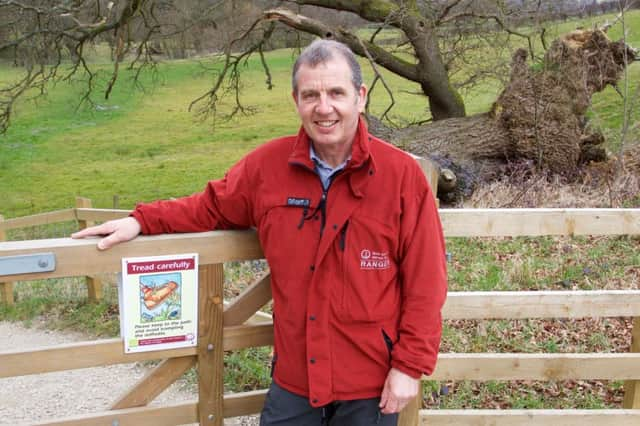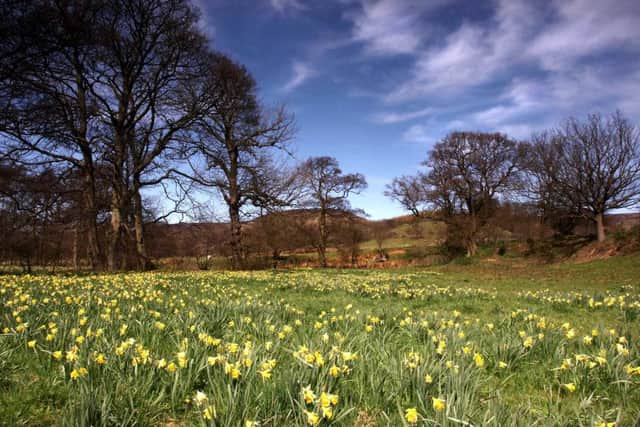Why are the Farndale daffodils late this year?


A few days later, though, they counted four and the day after that 40 were in bloom. Then their tally reached 90. The next day there were so many they gave up counting and the sighs of relief from the dalefolk were probably heard in Kirkbymoorside six miles away. Better late than never, they could announce the annual arrival of the Farndale Daffodils.
No one knows whether there are ten thousand of them or 100,000, such is the fluctuation in numbers, or why this part of Yorkshire has one of the UK’s biggest concentrations of Narcissus pseudonarcissus, the wild daffodil. Local legend has it they were planted by the Cistercian monks who lived at Rosedale Abbey on the other side of Blakey Ridge, but there is no historical evidence to back it up.
Advertisement
Hide AdAdvertisement
Hide AdWhat is known, though, is that Farndale’s daffodils are the most photographed and painted spectacle in the North York Moors National Park. And in March and April local fields become vast car parks to accommodate visitors from all over the North and the Midlands.


Back in the 1970s the Yorkshire Tourist Board, perhaps a little too zealous in promoting the area, suggested that these might even be the daffodils that inspired William Wordsworth to pen English poetry’s most famous lines. Wordsworth scholars, however, were quick to point out that his sister Dorothy wrote in her journal that William had, in fact, “wandered lonely as a cloud” on the shore of Ullswater in the Lakes.
Yorkshire shouldn’t begrudge Cumbria its Wordsworth daffodils, however. Farndale has infinitely more daffs than Ullswater, and while they may only appear for a month or so they are the tourist attraction that keeps on giving. The flowers are vital to the success of businesses like the well-named Daffy Cafe at High Mill and the pub at Church Houses. Community funds are also bolstered by selling tea and scones in the village bandroom at Low Mill. But no one takes the flowers for granted, and a daffodils thanksgiving service is held each April at one of the churches.
“We get 40,000 visitors to Farndale in only four weeks,” says the area’s National Park ranger David Smith. “Several thousand of them can swarm here on a fine day, and in such a small dale that can look like quite an invasion. The challenge for us is keeping to a minimum the disruption to local residents and the day-to-day running of Farndale. It isn’t just the feet on the paths, it’s the huge amount of traffic on our narrow roads.”
Advertisement
Hide AdAdvertisement
Hide AdThe daffodils’ fame goes back to the early 20th century, when in his guidebook Rambles in Cleveland a Teesside printer, Michael Heaviside, revealed that he had heard glowing accounts of Farndale’s “thousand upon thousands of daffodil blooms”.


But visitors picking the flowers had become a problem. “Amongst the dalesmen there is a good deal of dissatisfaction about the gathering of the daffodil crop,” wrote Heaviside, “and not without cause, as the invaders come into the dale from outlying towns in the dead of night, and in the early morning gather basketfuls for the market towns. These intruders are of a roughish type, and the peace-loving dalefolk have to bear the unwelcome visits of these robbers of their floral treasure with as good a grace as possible.”
After the First World War one guidebook author blamed the increasing ownership of motor cars for “an undesirable influx of daffodil-destroying maniacs”. In the 1930s another wrote: “I hesitate to say a word about them lest the despoilers who come in their charabancs by the thousand should pay a return visit in the hope of stealing some more. Not a solitary daffodil was left standing when I passed through in daffodil time, and if this is not vandalism what is?”
In towns as far away as Middlesbrough people can still remember women going round knocking on doors and selling bunches of wild daffodils from Farndale for one penny a bunch. Picking became so bad that local members of the Campaign for the Protection of Rural England organised a rota of patrols during the flowering season. But after the North York Moors National Park was set up in 1952 one of the earliest conservation measures was to formally protect the daffodils by creating the 2000-acre Farndale Nature Reserve.
Advertisement
Hide AdAdvertisement
Hide AdThat may have deterred the commercial pickers, but the water boards of Hull and Sheffield emerged as another threat. In the 1960s they thirsted after the creation of a huge dam that would have turned Farndale into a reservoir, a scheme which was eventually defeated by immense public outrage and a protest that became known as the Dambusters campaign.
Today, there are very few illegal pickers along the carefully managed mile or so of footpath between the villages of Low Mill and Church Houses. A sign at the start of the walk threatens visitors with a fine of £5, a quaint reminder from the 1950s rather than a serious threat. Under the Wildlife and Countryside Act 1981, though, anyone found picking wildflowers runs the risk of being fined up to £5000. That hasn’t happened yet, perhaps because of the presence of National Park ranger patrols or a more enlightened modern attitude to nature conservation which has made picking wildflowers frowned upon.
The unusually late appearance of the daffodils this year, delaying the peak blooming period until the first fortnight of April, is entirely due to the weather, says the National Park’s ecologist Rona Charles.
“It’s principally the soil temperature that influences their growth. Sunshine plays a part in as much as it warms up the ground, but the air temperature was low for four weeks before the usual flowering season, keeping the ground temperature down and pushing the daffodils’ appearance right back. Which is a pity, because the mild winter had probably put them on course to be early this year before the temperatures dropped.”
Advertisement
Hide AdAdvertisement
Hide AdThere is some evidence, both photographic and anecdotal, that the number of daffodils in Farndale has declined since the 1970s, but no one is sure why. Since picking is no longer the issue it once was, that leaves pressure from visitors or adverse climate conditions.
Rona admits to being puzzled, especially since stewardship agreements with local farmers have eliminated possible factors like the use of too much fertilisers and herbicides, and have reduced the risk of grazing and trampling by livestock.
In a bid to reverse the daffodils’ decline, Natural England has in recent years been carefully moving some of the flowers to less vulnerable spots where they can still be admired by visitors but also grow in more favourable and protected conditions. The small-scale experiment has been successful, and it is hoped the flowers will be reintroduced to other areas along the River Dove in which they are known to have once grown profusely.
Rona says: “There is now a good path and in theory there’s no reason why people should trample them down. We don’t want to put up too many signs or fences, so we have volunteer rangers asking people to stick to the paths. The trouble is, when you see a host of golden daffodils there’s nothing you want better than to wander amongst them and have your photograph taken. I can understand people wanting to get close to something wonderful, but I fear that may be part of the problem.”